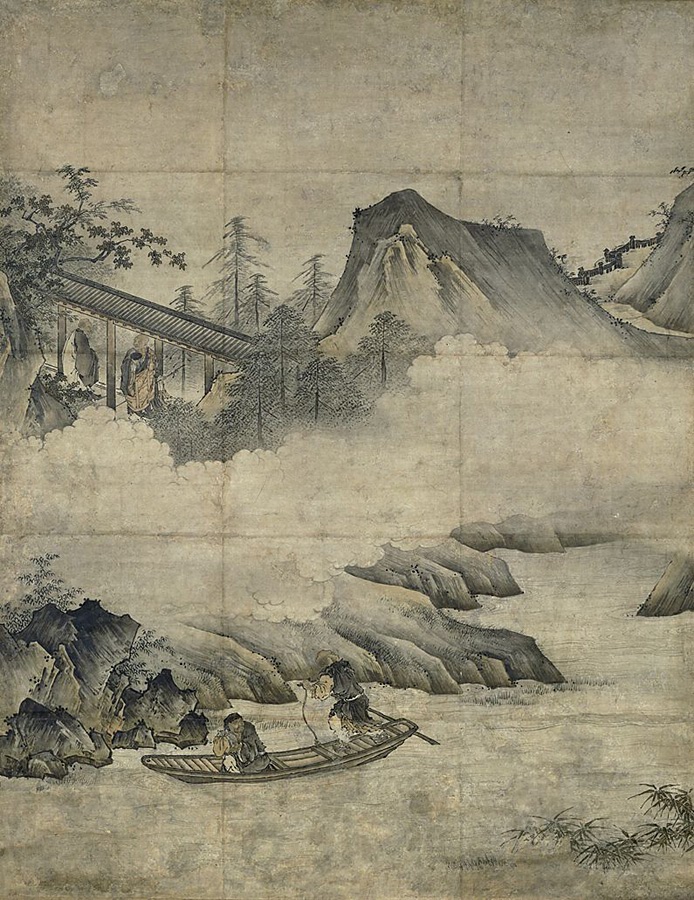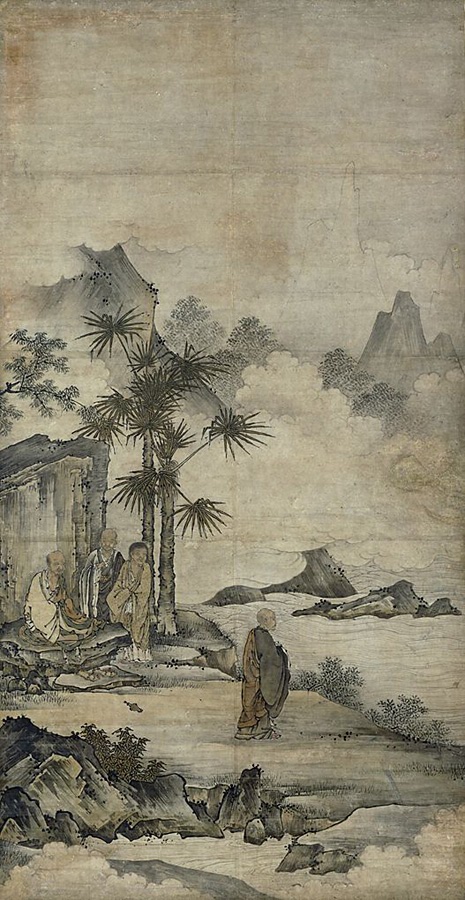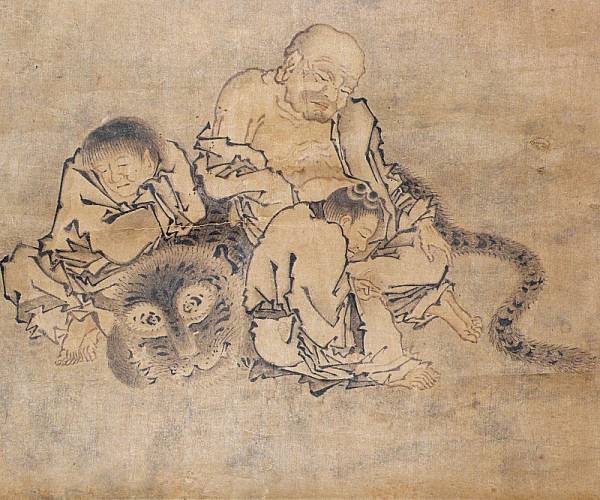ZEN MESTEREK ZEN MASTERS
« Zen főoldal
« vissza a Terebess Online nyitólapjára
狩野元信 Kanō Motonobu (1476-1559)
Kanō Motonobu, (born Aug. 28, 1476 —died Nov. 5, 1559, Kyōto) great master of Japanese painting.
https://www.britannica.com/biography/Kano-Motonobu
Like his father, Masanobu, the first of the Kanō painters, Motonobu served the Ashikaga shoguns (a family of military rulers who governed Japan from 1338 to 1573) and inherited the Chinese-inspired monochromatic ink-painting style (suiboku-ga, “water-ink painting”) favoured by the Ashikagas. Motonobu, however, was also the son-in-law of Tosa Mitsunobu, founder of the Tosa school of painting specializing in the native Yamato-e (Japanese Painting) style, and he effected a compromise by combining the strong brushwork of the Chinese suiboku-ga with the decorative appeal of the Yamato-e. The resulting style was especially suitable for large-scale compositions and practically dominated Japanese painting for the next 300 years.
A gifted and versatile artist, Motonobu excelled in landscapes (both in monochrome and in light colour), figures, and flower-and-bird pictures. He executed many paintings on the sliding panels of the Reiun-in monastery in Kyōto, where he decorated three rooms with landscapes painted in the styles of three different Chinese masters: the soft ink-wash style of Mu-ch'i Fa-ch'ang (late 12th–early 13th century); the hard, stiff style of Hsia Kuei (1195–1224); and the broken ink style of Yü Chien ( c. 1230). Some of Motonobu's paintings, originally done on sliding panels, were subsequently mounted on hanging scrolls; these include the important “49 Landscapes with Flowers and Birds” (also in the Reiun-in monastery), which prefigure the monumental decorative compositions of the later Kanō artists, Eitoku (1543–1590) and Sanraku (1559–1635).
旧大仙院方丈障壁画
Some of the works of the Paintings for the houjou (abbot's chamber) of the former Daisen-in
The twenty-four shouheki-ga (paintings on walls, sliding doors and free-standing screens) in the houjou (abbot's chamber) of the former Daisen-in are now owned by this museum. They were originally part of the group of shouheki-ga in the entire Daisen-in, a temple that was part of Daitoku-ji (Daitoku Temple) in Kyoto. They are in the hanging scroll form today, but were originally fusuma-e or kabe-haritsuke-e (paintings pasted onto walls).
Daisen-in is a tacchū (small temple attached to a bigger one) established by the celebrated monk, Kogaku Soukou (1465–1548) as his place for retirement in Eishou 10 (1513). As an existing houjou, it is the second oldest remaining building, next only to Ryougin-an of Tofuku-ji in Kyoto. With devotions from leading figures of the time, such as the emperor and the shogun, Kogaku appointed the best painters, including Souami and Kano Motonobu, for the production of shouheki-ga paintings in the houjou. Most of the major parts of those paintings have survived. Other than twenty-four pieces in this museum, there are also Shiki-sansui-zu (Landscapes of the Four Seasons by Souami, the central room) on sixteen scrolls, Shiki-kachou-zu (Paintings of Birds and Flowers of the Four Seasons by Kano Motonobu, the Danna room) on eight scrolls, and Shiki-kousaku-zu (Paintings of Farming Scenes in the Four Seasons handed down as by Kano Yukinobu, the Rai room) on eight scrolls.
祖師図(大満送大智・香厳撃竹)
Patriarchs (Daimansō Daichi and Kyougen Gekichiku)

Important Cultural Property
Attributed to Kanō Motonobu
2 hanging scrolls
(Some of the works of the Paintings for the houjou (abbot's chamber) of the former Daisen-in)
Ink and light color on paper
177.5x138.2 177.1x138.3
Muromachi period/16th century
Tokyo National Museum
A-288


祖師図(霊雲観桃・潙山踢瓶・三平開胸・石鞏張弓)
Patriarchs (Reiun Kantō, Izan Tekihei, Sanbei Kaikyou, and Sekkyō Choukyū)

Important Cultural Property
Attributed to Kanō Motonobu
4 hanging scrolls
(Some of the works of the Paintings for the houjou (abbot's chamber) of the former Daisen-in)
Ink and light color on paper
176.0x91.8,175.8x91.8,175.8x91.8, 176.0x91.8
Muromachi period/16th century
Tokyo National Museum
A-289





Awakening to the Way on Striking Bamboo 撃竹 悟道 図
Kanō Motonobu 狩野元信 (1476-1559) 16th century, Muromachi Period (1336 – 1573)
Encomium by Denan Sōki 伝庵宗器 (16 th century) (d. 1533)
Hanging scroll, ink and colours on silk, 89.2 x 44.4 cm
Kosetsu Museum of Art, Kobe

《 四睡図 》 Shisui
(The Four Sleepers = Bukan, Kanzan, Jittoku, and the Tiger)
by Kanō Motonobu 狩野元信 (1476-1559)